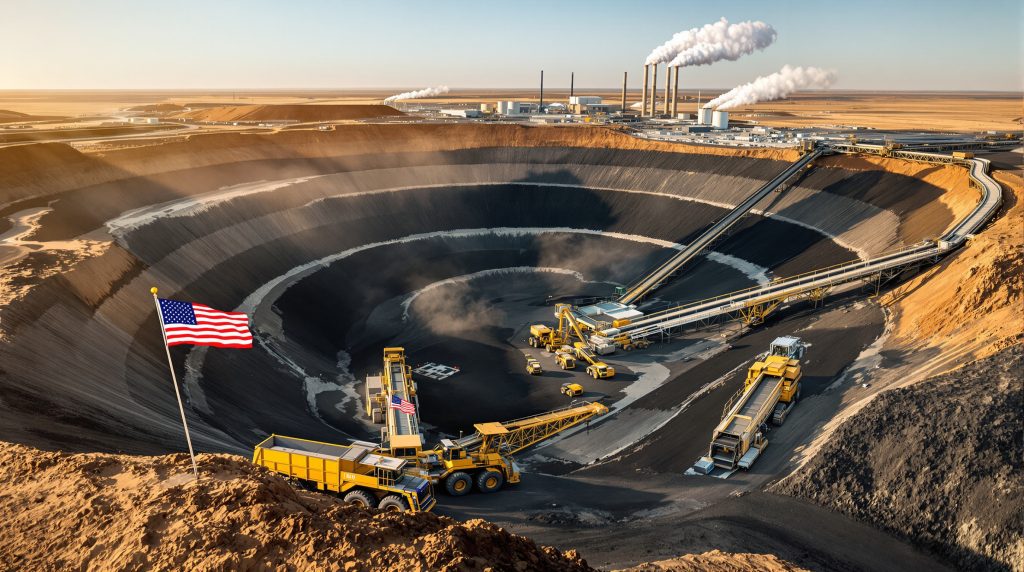Federal Coal Leasing: Understanding the Freedom Mine Deal
The Bureau of Land Management's recent coal lease sale at Freedom Mine represents a significant development in America's domestic energy landscape. This comprehensive analysis explores the details of the lease, its economic implications, and how it fits into broader energy transition and security considerations.
What is the Freedom Mine Coal Lease Sale?
The Freedom Mine coal lease sale marks a strategic transaction in federal resource management, providing continued access to North Dakota's energy resources while generating revenue for both state and federal governments.
Recent BLM Coal Lease Award Details
Coteau Properties Company, based in Beulah, North Dakota, secured valuable mining rights through a competitive bidding process. The company won the right to mine 18.3 million tons of federal coal reserves across 1,070 acres of land in Mercer County, North Dakota.
The financial terms of this transaction include a winning bid amount of $106,292 for the lease rights. Beyond this initial payment, the agreement includes ongoing financial obligations: annual rental fees of $3 per acre and a 7% production royalty on all coal extracted from the site. This royalty revenue will be divided equally between North Dakota's state government and the U.S. Treasury, creating a direct financial benefit at both governmental levels.
BLM Montana/Dakotas State Director Sonya Germann highlighted the broader significance of the deal, noting that it demonstrates the Bureau's commitment to responsible energy resource management while supporting domestic production and local employment opportunities.
Strategic Importance of the Freedom Mine
The Freedom Mine plays a crucial role in regional energy infrastructure. It serves as a primary supplier of coal to nearby Basin Electric Power Cooperative facilities, including the Antelope Valley Station and Great Plains Synfuels Plant. This consistent coal supply maintains reliable power generation capacity for communities across the region.
The newly secured lease extends the operational timeline of Freedom Mine through 2045, providing long-term stability for the facility and its workforce. This continuation of operations maintains critical regional energy infrastructure that communities have come to depend on for reliable electricity.
From a national perspective, Freedom Mine contributes significantly to domestic energy production capabilities, helping reduce dependence on imported energy resources. The mine represents an integral component of North Dakota's energy resource development strategy, which balances traditional fuel production with evolving mining industry trends.
How Does Federal Coal Leasing Work?
Federal coal leasing operates through a structured system designed to balance resource development with public interest, environmental protection, and fair market value for publicly owned resources.
BLM Coal Leasing Process Explained
The Bureau of Land Management administers a competitive bidding system for federal coal resources located on public lands. Companies interested in mining these resources must participate in lease sales where the highest qualified bidder typically secures the rights.
Before any lease sale occurs, the BLM conducts thorough environmental assessments in accordance with the National Environmental Policy Act. These reviews evaluate potential impacts on air quality, water resources, wildlife habitats, and cultural sites. Public comment periods during this process ensure community voices are heard and considered.
Lease terms are carefully structured to balance economic development with public interest considerations. The BLM maintains regulatory oversight throughout the mining lifecycle, from initial exploration through active extraction and eventual mine reclamation evolution. This oversight ensures compliance with all applicable laws and regulations governing resource extraction on federal lands.
The Freedom Mine lease exemplifies how this process integrates with broader federal energy resource management policies, which aim to support domestic energy production while ensuring environmental protection and fair returns to taxpayers.
Financial Structure of Federal Coal Leases
Federal coal leases incorporate multiple revenue streams for public benefit. The process begins with upfront lease payments based on competitive bidding, establishing the initial value of the resource rights. The Freedom Mine's winning bid of $106,292 represents this initial payment component.
Once a lease is secured, operators pay ongoing rental fees calculated per acre of leased land. For the Freedom Mine, this amounts to $3 per acre annually across the 1,070-acre parcel. The most significant financial component comes through production royalties, calculated as a percentage of extracted coal value. The standard 7% royalty rate applied to the Freedom Mine lease is consistent with federal coal leasing practices.
A key aspect of the financial structure involves revenue sharing mechanisms between federal and state governments. The 50/50 split between North Dakota and the U.S. Treasury ensures that both levels of government benefit from resource development. This arrangement recognizes the local impacts of mining activities while acknowledging the federal ownership of the resources.
Economic impact considerations play a crucial role in lease pricing determinations, with the BLM working to establish fair market value that appropriately compensates the public for resource extraction while maintaining economic viability for the operations.
What Are the Economic Implications of This Coal Lease?
The Freedom Mine coal lease creates ripple effects throughout the regional economy, from direct employment to broader community stability and public revenue generation.
Local Economic Benefits
Job preservation stands as one of the most immediate economic benefits of the Freedom Mine lease. The continued operation of the mine maintains direct employment for hundreds of workers in mining operations, providing stable, well-paying jobs in a rural economy. These positions require specialized skills and offer above-average wages compared to other regional employment opportunities.
Beyond direct employment, the lease supports regional power generation infrastructure that forms the backbone of the area's energy system. This reliable power supply attracts and retains other industries that depend on consistent, affordable electricity.
The lease contributes significantly to economic stability for Mercer County communities. The predictable employment and economic activity through 2045 allows for long-term community planning, investment, and development. This stability extends through multiplier effects in the local economy, as mining wages circulate through local businesses, housing markets, and service industries.
The supply chain impacts reach far beyond the mine itself. Local businesses providing equipment, maintenance services, transportation, and other support functions benefit directly from continued mining operations. The mine's activities generate substantial tax base contributions beyond direct lease payments, supporting local schools, infrastructure, and public services.
Revenue Generation Analysis
The Freedom Mine lease will generate considerable revenue over its lifetime. Based on the 18.3 million tons of coal covered by the lease and current market prices, the 7% production royalty will yield significant returns over the operational period. This revenue provides a steady, predictable funding source for both North Dakota and the federal government.
When compared to previous federal coal leases, the Freedom Mine agreement maintains consistent terms while reflecting current market conditions for coal resources. North Dakota's anticipated revenue share will support state infrastructure, education, and other public services, while federal treasury contributions bolster national programs.
From a cost-benefit perspective, the lease represents a strategic decision to generate economic value from existing resources rather than leaving them undeveloped. This approach maximizes the public return on federally owned resources while supporting regional coal mining economic boost.
How Does This Lease Reflect Current Energy Policy?
The Freedom Mine lease demonstrates the practical implementation of energy policies that balance traditional resource development with evolving market realities and environmental considerations.
Federal Energy Resource Management Strategy
The BLM's approach to the Freedom Mine lease illustrates how federal agencies balance domestic production priorities with environmental considerations. The competitive leasing process ensures fair market value while environmental assessments address potential impacts.
Recent policy directions have emphasized streamlining regulatory processes for energy development, reducing administrative barriers while maintaining necessary oversight. This approach supports traditional energy infrastructure during a period of energy transition, recognizing that existing systems require continued operation as new technologies develop and scale.
Regional economic development through resource utilization remains a core objective of federal land management policies. The Freedom Mine lease supports this goal by maintaining employment and economic activity in a rural area. The BLM's management of public lands for multiple-use objectives allows for resource extraction alongside other land uses, reflecting the agency's statutory mandate.
Coal's Evolving Role in Energy Markets
Coal occupies a strategic position in the current energy mix, particularly in regions with existing coal-based infrastructure. While overall coal usage has declined nationally, facilities like those supplied by Freedom Mine continue to provide reliable baseload power generation.
The industry faces market challenges from competing energy sources, particularly natural gas and renewable energy. Coal-producing regions and companies have developed adaptation strategies to navigate these changing market conditions, focusing on efficiency, cost control, and supplying reliable customers.
Infrastructure dependencies on reliable coal supplies remain significant in regions like North Dakota, where power generation systems were designed around local coal resources. Transition planning within the broader energy landscape acknowledges these dependencies while preparing for longer-term changes in energy exports challenges.
The Freedom Mine lease represents a balance between energy security goals and environmental objectives, allowing continued operation of existing infrastructure while other energy sources develop and expand their capacity.
What Environmental Considerations Apply to This Lease?
Environmental management forms a critical component of modern coal leasing, with multiple layers of oversight and requirements throughout the mining lifecycle.
Environmental Assessment Process
Before approval of the Freedom Mine lease, the BLM completed required environmental reviews to evaluate potential impacts on air, water, wildlife, and cultural resources. These assessments analyzed the mine's potential effects on groundwater quality, surface water resources, air emissions, and habitat disruption.
Public input opportunities during assessment phases allowed community members, environmental organizations, and other stakeholders to provide feedback on the proposed lease. This input helped shape the final decision and any required mitigation measures.
The lease includes specific mitigation requirements for potential impacts identified during the review process. These requirements address issues such as dust control, water management, and habitat protection. Ongoing monitoring provisions throughout the lease term ensure continued compliance with environmental standards and permit conditions.
The environmental assessment process exemplifies how resource development can be balanced with environmental protection through careful planning, analysis, and adaptive management.
Reclamation and Sustainability Practices
Modern coal mining operations include comprehensive land restoration requirements that take effect after mining activities conclude. The Freedom Mine lease incorporates these obligations, ensuring that disturbed areas will be returned to productive use.
Advanced mining techniques help minimize the environmental footprint of operations, reducing impacts on surrounding areas. Water quality protection measures address potential concerns about contamination of groundwater and surface water resources, while air quality management requirements limit emissions from mining activities and associated operations.
The lease includes provisions for long-term site management planning, extending beyond the active mining period to ensure successful reclamation and sustainable post-mining land use. These practices reflect the industry's evolution toward more environmentally conscious resource extraction methods.
How Does This Compare to Other Federal Coal Leases?
The Freedom Mine lease fits within established patterns of federal coal leasing while reflecting specific regional and operational characteristics.
Comparative Analysis of Recent Coal Leases
In terms of lease size and coal quantity, the Freedom Mine's 1,070 acres and 18.3 million tons place it in the mid-range of federal coal leases. Some western leases cover larger areas with greater coal volumes, while others involve smaller parcels targeted for specific operations.
Analyzing bid amounts on a per-ton basis, the Freedom Mine lease price of approximately $0.006 per ton aligns with recent leasing trends for similar coal types and locations. The $3 per acre annual rental fee and 7% royalty rate represent standard terms that have been consistent across federal coal leases in recent years.
Regional variations in lease terms and conditions reflect differences in coal quality, mining methods, and market access. The Freedom Mine lease includes provisions specific to the North Dakota location and mining operations while maintaining consistency with broader federal leasing practices.
Historical trends in federal coal leasing activities show cyclical patterns influenced by energy market conditions, regulatory changes, and policy priorities. The BLM coal lease sale at Freedom Mine represents a continuation of established leasing practices within this evolving context.
Market Position of Freedom Mine
The Freedom Mine's production capacity places it among significant U.S. coal operations, particularly within the lignite coal sector that predominates in the region. The mine's annual production capabilities support its role as a key supplier to nearby power generation facilities.
The quality characteristics of Freedom Mine coal, primarily lignite with relatively low sulfur content, make it well-suited for the specialized power plants designed to use this fuel type. These quality factors influence both the mining methods employed and the market value of the resource.
The mine's strategic importance within regional energy infrastructure stems from its direct connection to Basin Electric Power Cooperative facilities, which were designed specifically to utilize local coal resources. This dedicated customer relationship enhances the mine's competitive positioning in changing energy markets.
Long-term viability assessments indicate that Freedom Mine operations remain economically sustainable through the lease period, particularly given the dedicated customer base and established infrastructure.
What's the Future Outlook for Federal Coal Leasing?
The landscape for federal coal leasing continues to evolve in response to changing energy markets, policy priorities, and technological developments.
Projected Trends in Federal Coal Management
Federal coal management will likely continue to adapt to changing energy market conditions. Leasing activities may become more targeted, focusing on extensions of existing operations rather than new mine development. This approach maximizes the value of existing infrastructure while acknowledging shifting energy consumption patterns.
Market forces will play an increasing role in shaping future lease valuations, with competition from other energy sources influencing the economic value of coal resources. Federal agencies will continue balancing energy transition objectives with the need to support existing infrastructure during the transition period.
Regional economic considerations will likely remain important factors in future leasing decisions, particularly in communities with significant dependence on coal-related employment and economic activity. Technological developments affecting coal utilization, including potential carbon capture implementations, could influence the viability and value of federal coal resources.
Long-term Implications for Energy Infrastructure
Infrastructure dependencies on continued coal supply create complex transition challenges for regions like North Dakota. Power plants, transmission systems, and supporting facilities were designed around specific fuel sources and cannot be easily or quickly replaced.
Adaptation strategies for the changing energy landscape include operational efficiency improvements, potential fuel flexibility modifications, and gradual diversification of energy sources. Investment considerations for coal-dependent facilities increasingly focus on maintenance and efficiency rather than major capacity expansions.
Transition planning horizons for regional energy systems typically extend over decades rather than years, allowing for gradual adaptation while maintaining reliable service. The integration of emerging energy technologies provides opportunities to supplement and eventually replace traditional coal-based generation, but this process requires time, investment, and careful planning.
Key Data: Freedom Mine Coal Lease by the Numbers
| Aspect | Details |
|---|---|
| Lease Recipient | Coteau Properties Company (Beulah, ND) |
| Location | Freedom Mine, Mercer County, North Dakota |
| Acreage | 1,070 acres |
| Coal Quantity | 18.3 million tons |
| Lease Price | $106,292 |
| Annual Rental | $3 per acre |
| Royalty Rate | 7% of coal produced |
| Duration | Through 2045 |
| Revenue Sharing | 50% North Dakota, 50% U.S. Treasury |
| Primary Coal Users | Basin Electric Power Cooperative facilities |
Federal Coal Leasing: Common Questions Answered
Why is the Freedom Mine coal lease economically significant?
This lease ensures continued operation of the Freedom Mine through 2045, providing long-term stability for regional energy production. The economic significance extends beyond the direct lease payments to include job preservation, support for power generation infrastructure, and broader economic stability throughout Mercer County and surrounding areas. The royalty revenue stream benefits both state and federal governments, creating ongoing financial returns from resource development.
How are royalty payments calculated and distributed?
Royalty payments are calculated at 7% of the value of coal produced from the leased area. This standard rate applies to surface-mined coal on federal lands. The resulting revenue is divided equally, with 50% going to the State of North Dakota and 50% to the U.S. Treasury. This revenue-sharing approach recognizes both the local impacts of mining activities and the federal ownership of the resource.
Which power facilities depend on Freedom Mine coal?
Freedom Mine primarily supplies coal to nearby power generation facilities operated by Basin Electric Power Cooperative. These include the Antelope Valley Station, a coal-fired electric generating plant, and the Great Plains Synfuels Plant, which produces synthetic natural gas from coal. These facilities form critical components of the regional energy infrastructure and were designed specifically to utilize local lignite coal resources.
What environmental reviews occur before lease approval?
Before approving a coal lease, the BLM conducts environmental assessments in accordance with the National Environmental Policy Act. These reviews evaluate potential impacts on air quality, water resources, wildlife habitats, cultural resources, and socioeconomic factors. The process includes public comment periods allowing community input on the proposed action. For the Freedom Mine lease, these reviews confirmed that the extension of mining activities could proceed with appropriate mitigation measures and ongoing monitoring.
How does federal coal leasing contribute to domestic energy security?
Federal coal leasing supports domestic energy security by providing reliable fuel supplies for existing power generation infrastructure. While the energy landscape continues to evolve, facilities like those supplied by Freedom Mine play important roles in maintaining grid stability and reliable electricity production. The predictable nature of coal-based generation complements more variable renewable energy sources, contributing to overall system reliability during the energy transition period.
Ready to Stay Ahead of Major ASX Mineral Discoveries?
Don't miss the next market-moving announcement – Discovery Alert's proprietary Discovery IQ model provides instant notifications when significant discoveries are made on the ASX, giving you the opportunity to act before the wider market. Visit our discoveries page to see how our alerts have helped investors capitalise on transformative mineral finds.




